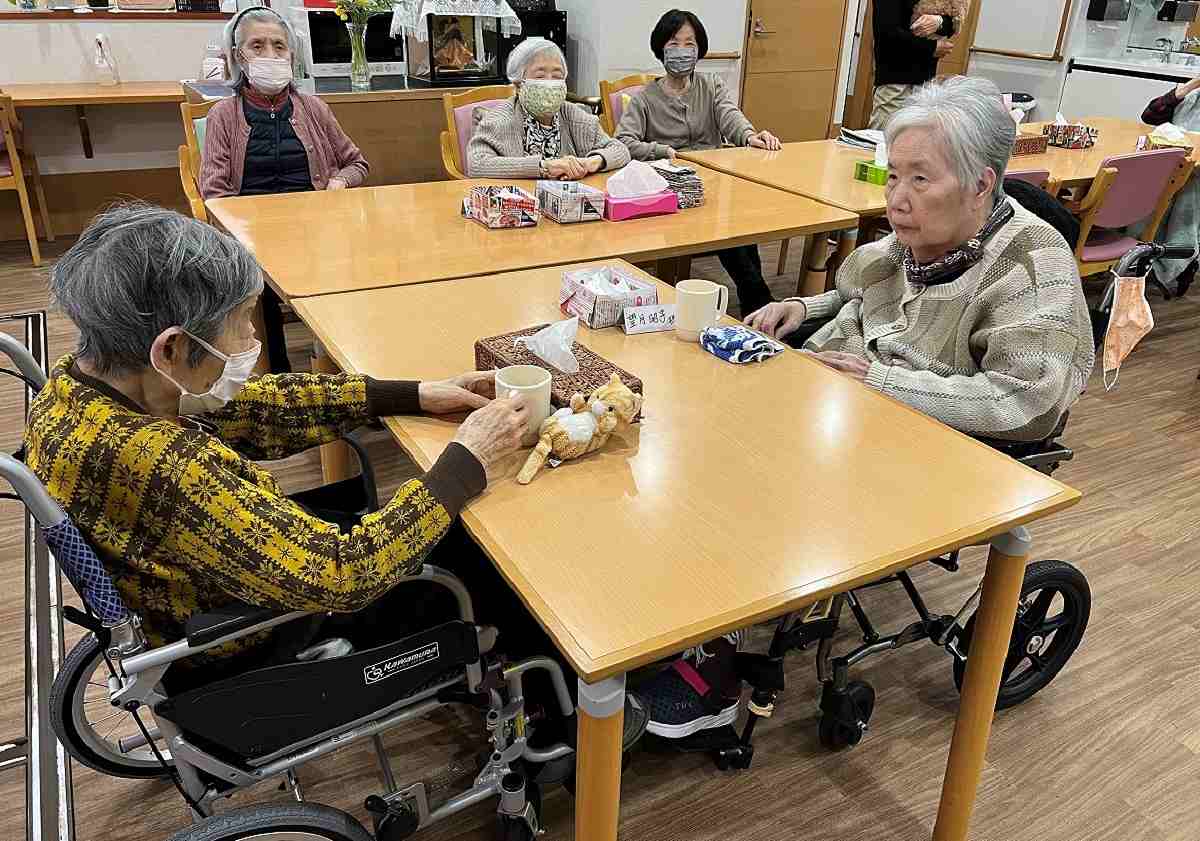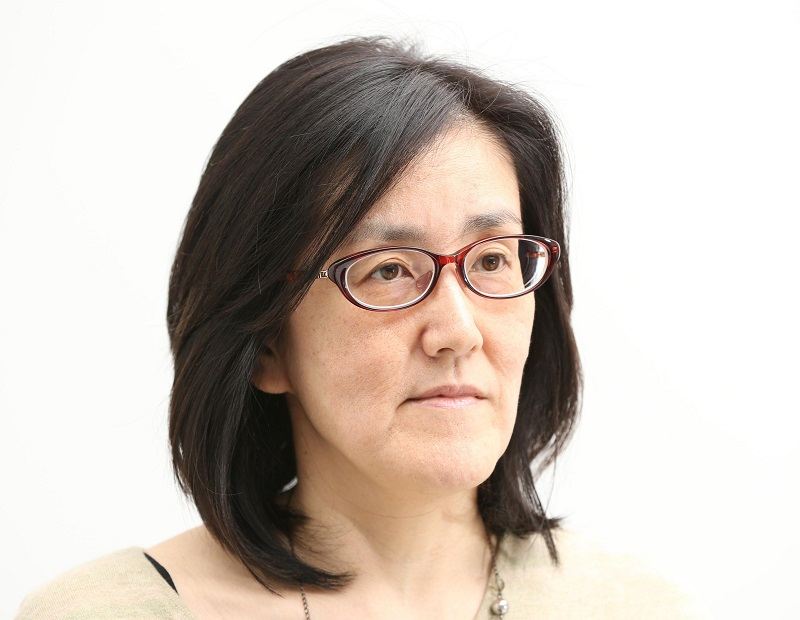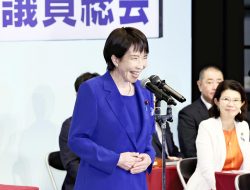
Elderly people are seen at Miyanoya, a small day care facility in Itabashi Ward, Tokyo, in March. Japan’s nursing care industry continues to face a shortage of young personnel.
8:00 JST, April 1, 2023
With Japan’s declining birthrate and aging population, there is a serious shortage of young human resources in all fields. The nursing care industry, where demand is growing, has been especially hard-hit.
Keiko Kobayakawa is a visiting caregiver in Itabashi Ward, Tokyo, with over 20 years of experience. Currently, she makes the rounds of two or three homes a day on her bicycle, four days a week, assisting elderly people with meals and medications as well as taking care of their toilet needs. She likes this job, which allows her to work one-on-one with care recipients, and she plans to keep going as long as she can. Her only worry is her age; when her birthday comes this month, she will turn 74.
“Caregiving needs physical strength. I was fine in my 60s, but after I hit 70, I started to feel like I was losing my strength,” she said. She also suffers from sciatic nerve pain and cannot move when the pain becomes severe, so she goes to rehabilitation twice a week between jobs.
The Care Work Foundation — a public interest incorporated foundation supporting care workers — conducted a nationwide survey of approximately 9,000 nursing care facilities in October 2021 and found that the average age of visiting caregivers was 54.4. This was the highest among all nursing care occupations surveyed and was 3 years older than the average age in 2012.
According to Kayoko Miyata, the 61-year-old representative of Asahi Staff Service, a service provider with whom Kobayakawa is registered, the company’s approximately 20 visiting caregivers are mainly in their 60s, with the oldest one in her 80s. They sometimes care for people younger than themselves. “There are almost no young applicants for visiting care service. Even if they enter with ambition, they don’t last,” Miyata said. Unlike nursing care facilities, where people can work without official qualifications, visiting caregivers need to be qualified. However, even if one spends the time and money to become qualified, the remuneration is low compared to other industries, making it difficult for young people to envision a future for themselves in the field.
Home care companies are withdrawing from some areas due to a shortage of caregivers, leaving no services available.
The problem is not limited to home-visit care. According to the survey, the average age of all nursing care workers, including facility workers, was 50 in 2021, up by 5 years from the average in 2012. In addition, 63% of the businesses felt that there was a shortage of human resources.
Such a serious shortage of human resources is now greatly shaking the long-term care insurance system that supports Japan’s fast-aging population.
The long-term care insurance system, introduced in 2000, is a system in which residents aged 40 or older enroll and municipalities provide long-term care services based on insurance premiums and public funds. To use the services, one needs to apply to the relevant municipality, which certifies the need for long-term care on a five-level scale. Those who have been certified can use various services including home-visit care and day care, as well as nursing care equipment, according to their level of certification. The insurance covers 70% to 90% of the service-related expenses, while the users pay the remaining 10% to 30% depending on their income and other factors.
Since its introduction, the number of users of long-term care insurance has been increasing every year. According to statistics from the Health, Labor and Welfare Ministry, there were on average 5.75 million recipients per month of long-term care services nationwide, and the total amount of benefits was ¥10.231 trillion in fiscal 2020. Both of these figures are about three times higher than in fiscal 2000.
Users have also changed significantly. “The nursing care field is like a microcosm of society,” said Tomoko Ito, a care manager in Tokyo. Against the backdrop of social changes such as the rise in the percentage of unmarried people and the increase in non-regular workers since the 1990s, “Increasing numbers of elderly people live alone with no relatives, with small pensions, and with mental illnesses. As a result, the cases requiring a variety of lifestyle or medical support measures in addition to nursing care are increasing,” said Ito. The burden on care managers, who make a care plan for each recipient in coordination with other public welfare offices, continues to rise.
According to an estimate by the health ministry, there will be a shortage of 320,000 caregivers including those at care facilities by 2025, when the baby boomers — born from 1947 to 1949 — will all have reached 75. It is also said there will be a shortage of 690,000 caregivers by 2040, when the children of the baby boomers will themselves become elderly citizens. The central government has announced that it will accept up to 60,000 foreign workers into the nursing care industry over five years under a new residency status introduced in fiscal 2019, but this alone will not be enough to solve the labor shortage.
“There is no game-ending home run for the problem,” said Takashi Mihara, senior researcher at the NLI Research Institute in Tokyo. He emphasizes the need to continue doing everything possible to address it. The first and most important step is to secure financial resources and realize further increases in care workers’ salaries. According to Mihara, even taking into consideration last year’s measures to raise compensation for care workers, their average monthly wage is estimated at ¥293,000, compared to the overall private sector average of ¥352,000.
Mihara also said utilizing information technology, robots and volunteers would be effective measures.
In 2022, the number of births in Japan fell below 800,000 for the first time since statistics began in 1899. Prime Minister Fumio Kishida, with a heightened sense of crisis, has expressed his determination to launch measures against the low birthrate on an “unprecedented scale.” This of course is important, but at the same time, it is also essential to review the social security system, including long-term care, to make it sustainable in the coming super-aging society.
The long-term care insurance system will not last as it is if it relies on mutual help among the elderly. Many people involved in the industry worry that if no effective measures are taken, there will be a large number of people who need nursing care but are left without it in the near future.
“The next six to seven years will determine if we can reverse the declining birthrate trend,” Kishida said at a news conference in March. We should also tackle the problem facing the nursing care industry with a level of urgency that is at least as serious.
Political Pulse appears every Saturday.

Ikuko Higuchi
Higuchi is a staff writer in the Lifestyle News Department of The Yomiuri Shimbun.
"Editorial & Columns" POPULAR ARTICLE
-

Violations of Subcontract Law: Major Automakers Must Eliminate Old Practices
-

Local Governments’ Tax Revenues: Devise Ways to Correct Imbalances in Tax Sources
-

5 Japanese Business Dinner Mistakes to Avoid — and What They Taught Me About Business in Japan
-

Heavy Rains in Asia: Support for Victims, Flood-Control Measures Urgently Needed
-

Rice Coupons: A Misguided Approach to Countering Rising Prices
JN ACCESS RANKING
-

Keidanren Chairman Yoshinobu Tsutsui Visits Kashiwazaki-Kariwa Nuclear Power Plant; Inspects New Emergency Safety System
-

Imports of Rare Earths from China Facing Delays, May Be Caused by Deterioration of Japan-China Relations
-

University of Tokyo Professor Discusses Japanese Economic Security in Interview Ahead of Forum
-

Japan Pulls out of Vietnam Nuclear Project, Complicating Hanoi’s Power Plans
-

Govt Aims to Expand NISA Program Lineup, Abolish Age Restriction
























